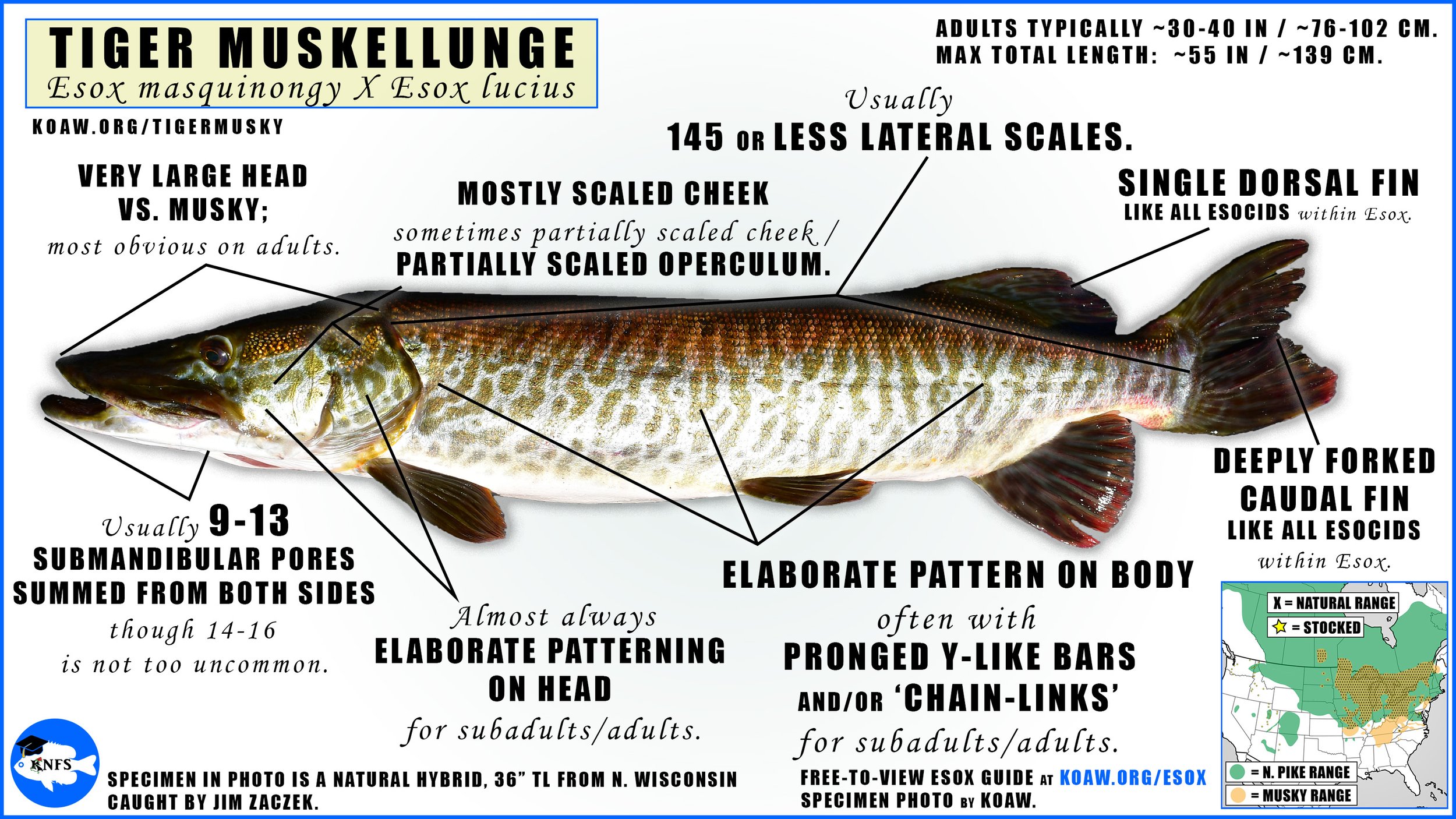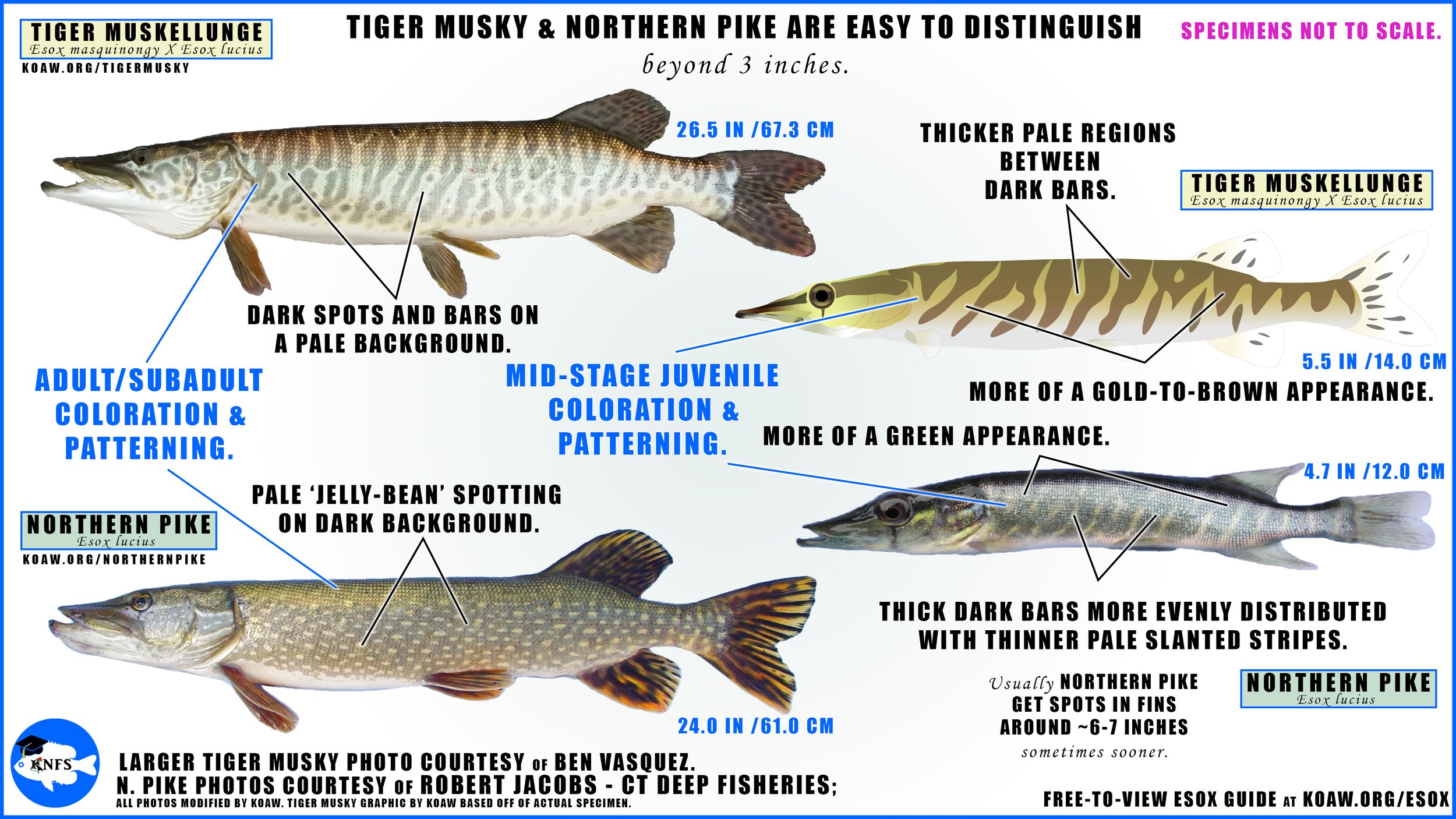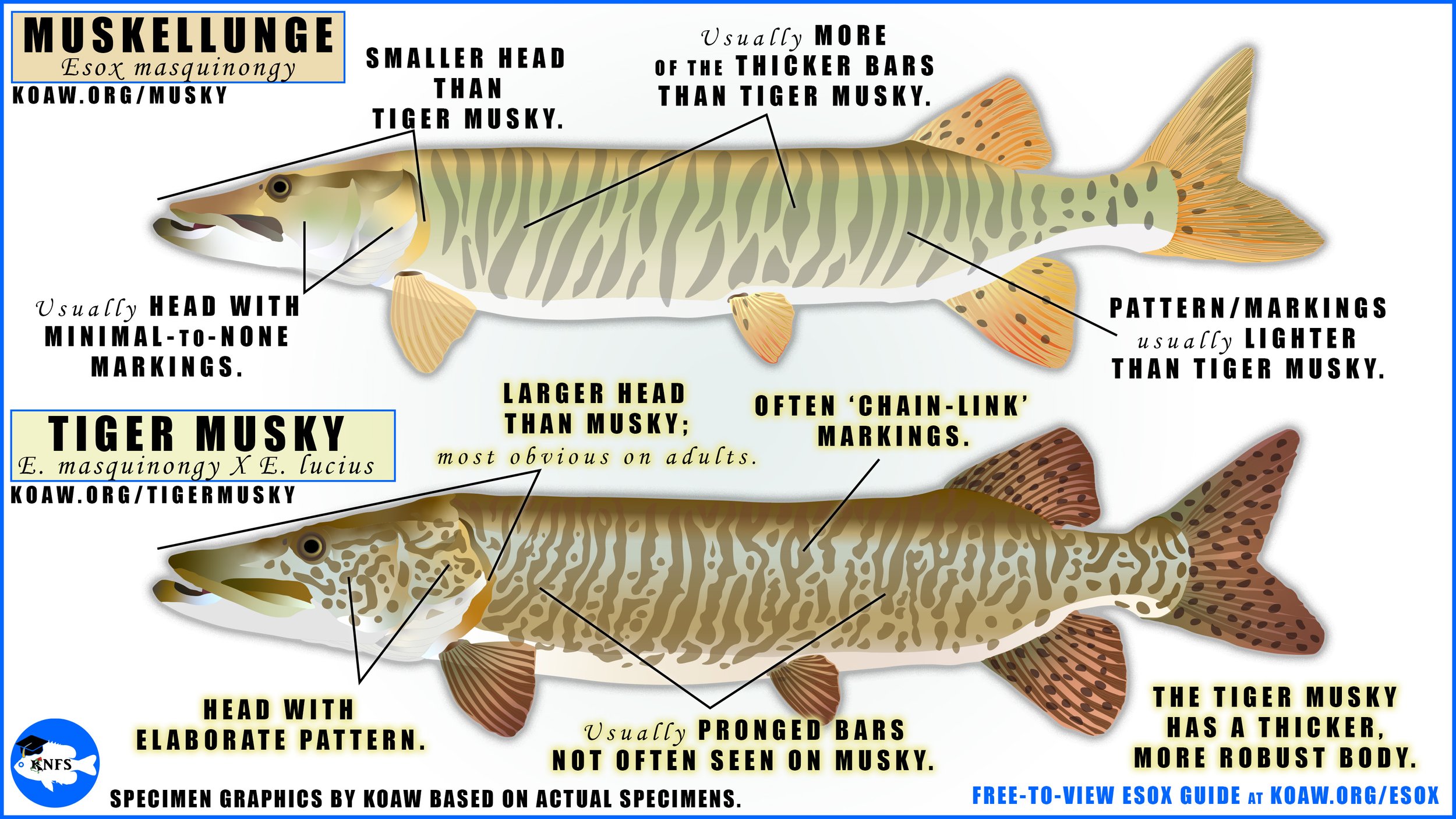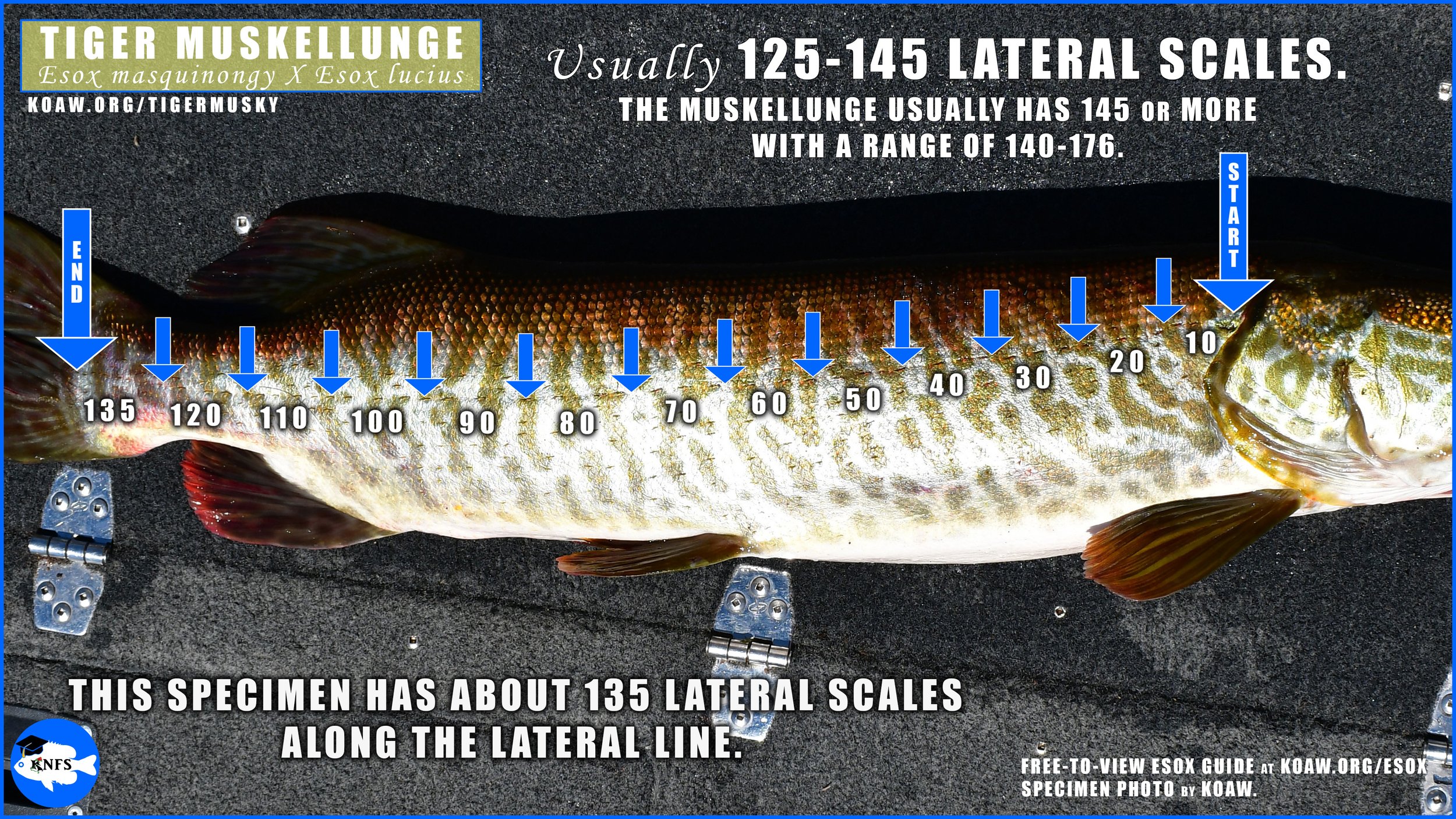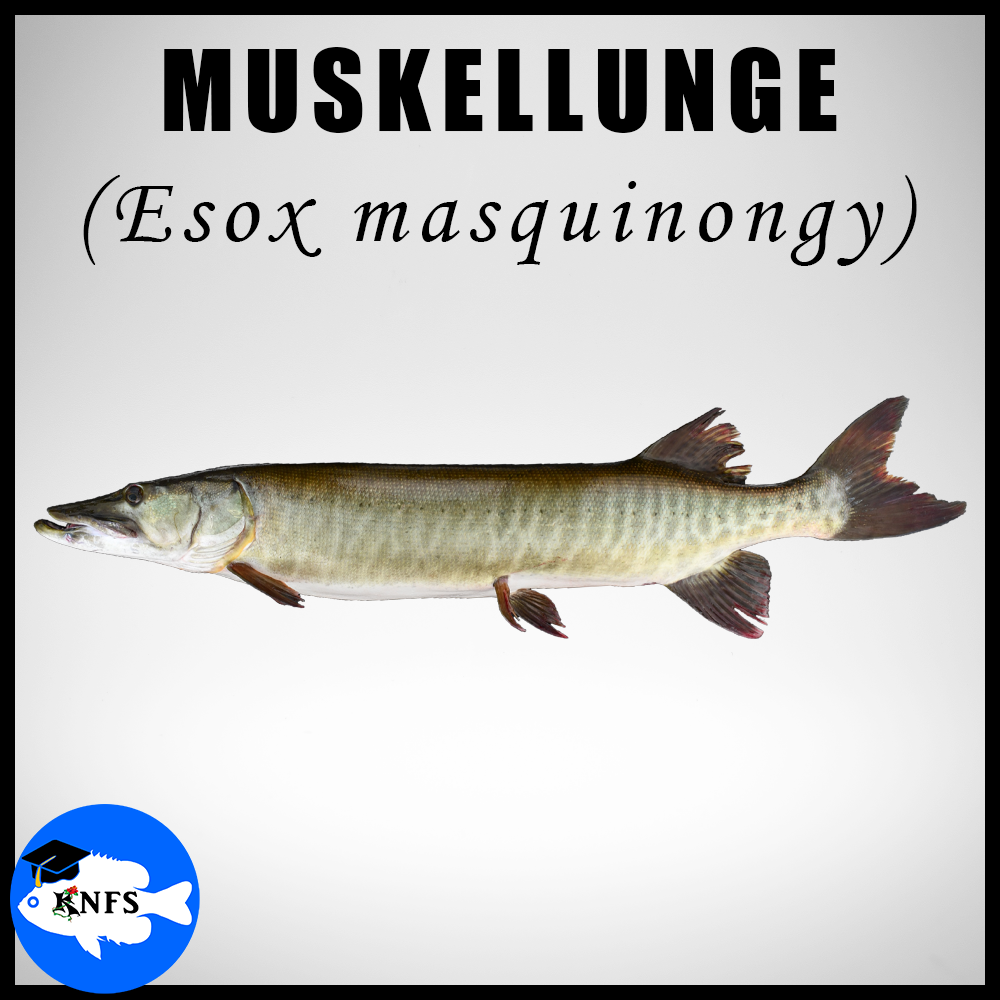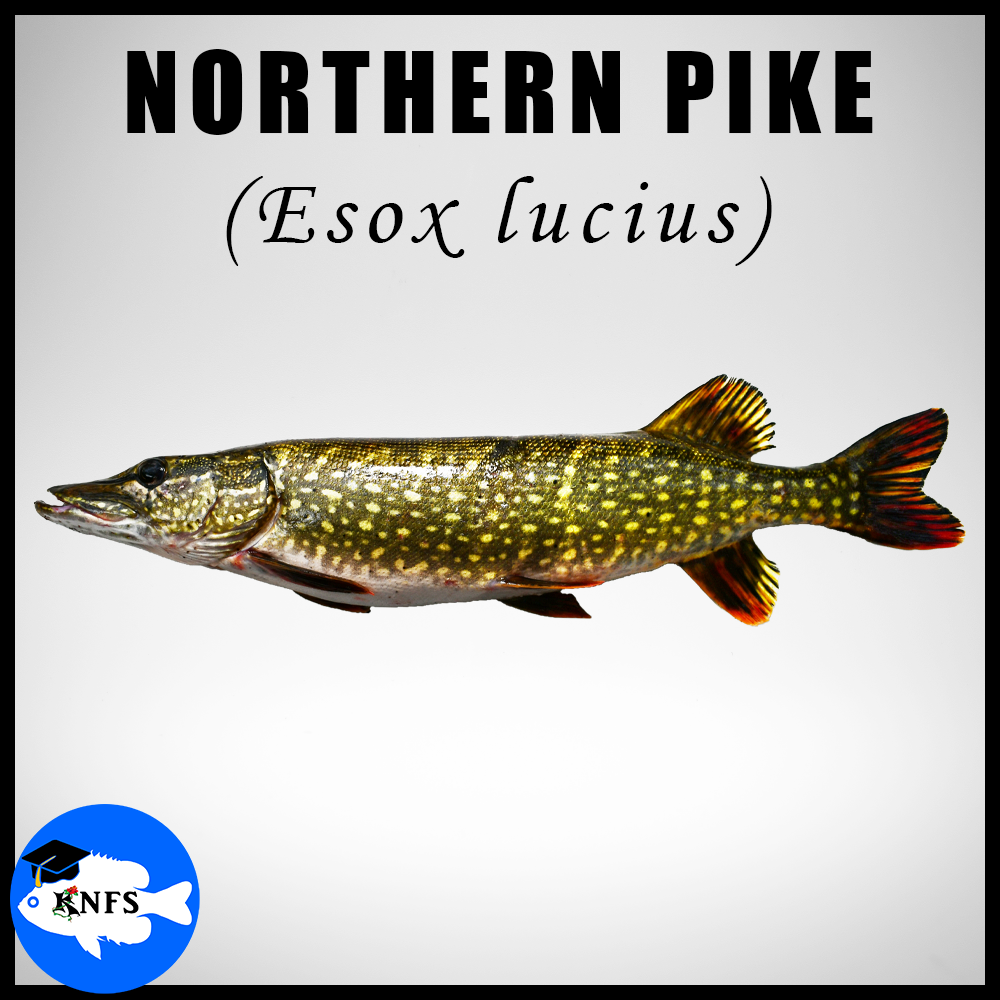By Koaw 2023,
BEST FEATURES FOR ID: (All of these features are discussed below in detail.)
Examine the cheek and operculum.
Count the submandibular pores.
Get a count on the lateral line scales.
Count the branchiostegal rays.
Examine the patterning.
Entering the values of the above features into the Quick Esox ID App will provide a fast analysis.
A Morphometrics Calculator is also available here that helps differentiate subadult/adult muskellunge, tiger muskellunge, and northern pike, especially helpful for those tricky-to-ID tiger muskellunge.
Features that are meristic (countable) and morphometric (measurable) are very reliable for identification. Patterning and coloration are also important features to examine. A combination of features should always be examined for a confident ID on any fish.
INTRO: The tiger muskellunge, tiger musky, or tiger muskie (E. masquinongy x E. lucius) is a hybrid between the muskellunge (Esox masquinongy) and the northern pike (Esox lucius). This hybrid remained fairly unknown until the early twentieth-century, only mentioned in publications perhaps as early as 1927. [1]
Click to enlarge.
The tiger musky hybrid is most often produced by a female muskellunge and a male northern pike; the reciprocal cross is also viable. Hatcheries that stock tiger muskellunge almost exclusively use eggs from a female muskellunge and a male northern pike; this cross offers a more desirable survivability and growth of offspring. The tiger muskellunge is generally cheaper to rear and grows faster in the first year than either parent species, and as such, is a desirable fish to stock for sportfishing as well as for the purposes of managing fish community structures in certain bodies of water. [2] [3] [4] [5]
The tiger muskellunge is essentially a functionally sterile fish, as in, this hybrid cannot reproduce with great success in the wild with the muskellunge, northern pike, and other tiger muskellunge. This sterility makes the tiger muskellunge appealing to stock in various situations as there is no worry of an uncontrolled population expansion. Males are considered entirely sterile. However, under lab conditions, with the injection of external hormones and extraction of eggs from a female tiger muskellunge and the mixing of sperm from a male northern pike, survivable offspring from this backcross have been produced. [6] There is ongoing research to determine the extent of hybridization and possible introgression between certain populations of northern pike and muskellunge. [7]
The first artificially produced tiger muskellunge is reported from the 1930’s. Also in this decade, an early notable crossing event occurred in Minnesota when the northern pike as well as the ‘silver pike’ (a morph of northern pike), then thought to be a ‘silver muskellunge’, was crossed with muskellunge, with all combinations of parental sexes; all of these crossings produced viable offspring. [8]
Natural occurrences of tiger muskellunge were once thought to be extremely rare, however, it’s most likely that misidentification with muskellunge led to the extremely low reported observations of hybrids. Though still rare from natural crosses, the tiger muskellunge remains the most commonly encountered hybrid type within the genus Esox. [9] The natural hybrid is most likely to be found in smaller body of waters where spawning grounds are limited, allowing for more interactions during spawning periods between northern pike and muskellunge.
The tiger muskellunge is most often confused with the muskellunge, especially with muskies that are heavily barred and/or with spotting. The tiger muskellunge is not often confused with the other parent species, the northern pike, as the tiger musky hybrid does not share the similar ‘jellybean’ patterning and overall coloration of the northern pike.
In parts of Minnesota and Wisconsin the muskellunge (E. masquinongy) was once commonly referred to as a “tiger musky” in local vernacular. [9] All mentions of “tiger musky” and “tiger muskellunge” in this guide refer to the hybrid (E. masquinongy x E. lucius), as is normal in current publications regarding Esox. “Norlunge” is another name that the tiger muskellunge has gone by, mostly in New York. [10]
KEY FEATURE #1 – SCALES ON THE CHEEK & OPERCULUM: Examining the scalation on the cheek and operculum is usually the best feature to first examine on any pike, pickerel, musky, and possible hybrid. These scales will be fully developed and readily visible on all specimens except for the youngest of juveniles; some juveniles of the larger species (below ~8 in/20 cm TL) may still not yet show scales.
The tiger muskellunge will usually show a cheek that is mostly scaled (usually around ~80-90%) and an operculum that is partially scaled. However, it’s not uncommon for the cheek to be partially scaled below 70% coverage on a tiger muskellunge, more resembling the partially scaled cheek seen on the muskellunge. If the cheek is mostly scaled and the operculum is partially scaled, and the fish looks like a musky/tiger musky, then it is most likely a tiger musky. [11] [6] [8] Of course, it’s advised to examine more features for a more confident ID.
The northern pike, like the tiger muskellunge, most often shows a mostly scaled cheek and a partially scaled operculum. The chain pickerel (E. niger) and the American pickerel (E. americanus) (including the subspecies grass/redfin/intergrades), all show a mostly scaled cheek and mostly scaled operculum.
BODY: The tiger muskellunge, like all the members of Esox, has an elongated body with a single dorsal fin far back on the body that sits above an anal fin of similar size. The caudal fin (tail fin) is deeply forked, of which, separates this fish easily from any of the similarly shaped gars, of which, all have rounded caudal fins. The tiger muskellunge generally has a much more robust, thicker body than the muskellunge, primarily evident on adults and subadults. The mouth is full of many sharp teeth; anglers should never ‘lip’ a tiger muskellunge with a bare hand.
Esocids within the genus Esox are lie-and-wait predators. The body is designed for quick bursts of speed from a still position to nab prey. The tiger muskellunge is primarily piscivorous (eats fish) but will be an opportunistic feeder. [12] [2]
KEY FEATURE #2 – SUBMANDIBULAR PORES: A count on the submandibular pores may offer clarity to an ID. These pores are found on the underside of the jaw and are obvious holes. These pores should be easily visible on specimens larger than 12 in (30 cm). Small specimens will most likely require a magnifying glass. Only count fully developed/obvious pores.
The tiger muskellunge will most often show between 9-13 pores if totaling the pores from both sides. These counts usually appear as 4/5, 5/5, 5/6, 6/6, & 6/7. For example, a count of 5 pores on the left side and 6 pores on the right side appears as 5/6. A higher count appears on roughly ~25% of tiger musky specimens with 7/7, 7/8, and 8/8 pore counts. And though rare, a 9/8 count has been observed for the tiger musky. [6]
The muskellunge almost always has 6 or more pores on each side, with a summed range of 12-20. Ergo, if a fish appears to be a muskellunge/tiger muskellunge and has 4/5, 5/5, or 6/5 submandibular pores, then it is most likely a tiger muskellunge. However, the muskellunge will show a 6/5 count of submandibular pores with very low frequency, hence why examining more than one feature is very important.
A lateral line scale count (discussed below) will most likely be the last needed feature to examine for differentiating the tiger musky vs musky. (Again, all of these meristics can easily be plugged into the Quick Meristics Key for a fast analysis. And consider trying out the Morphometrics Calculator for a more thorough examination of a possible tiger muskellunge.)
The northern pike usually always has 5/5 pores while 4/5 and 5/6 are not too uncommon. The pickerels (chain/grass/redfin) almost always have 4/4 pores on the underside of the jaw where 4/5 and 4/3 counts are also encountered with some frequency, and rarely, 6 pores are observed on a single lateral side.
PATTERNING/COLORATION: Very young tiger muskellunge will look very different from fully mature adults. A mature tiger muskellunge is often a very vibrant, beautifully patterned fish. Both the color and patterning are far more similar to a muskellunge than a northern pike. Tiger muskellunge will never have the ‘jellybean’ pattern seen on northern pike.
There are not many obvious differences between the reciprocal crosses of the tiger muskellunge (the female muskellunge x male northern pike & male northern pike x female muskellunge.) Eddy (1944) noticed no differences between the reciprocal crosses in the juvenile stage while Crossman & Buss (1965) notes the female muskellunge x male northern pike cross for specimens in the range of 170-194 mm SL had longer and narrower bars along the body without large spots beneath them while the reciprocal cross had more pigment on the head, oval spots on the side of the body, and a single, pronounced spot within the anal fin. [8] [9]
At times the patterning/coloration of the tiger muskellunge is extremely similar to a pure muskellunge, especially true of certain populations of musky from Wisconsin and Minnesota. Any tiger muskellunge should always be confidently differentiated from the muskellunge based off of meristics and morphometrics (all discussed by the key features on this page) as well as color/patterning; IDs should not be based entirely on color/patterning.
The tiger muskellunge has a dark dorsal side, with colors of green, gold, yellow, and brown, that becomes lighter along the side into an almost all white-to-cream breast & belly. The pattern on the body is often darker than what is seen on a muskellunge. This pattern is often a shade of green-to-brown on a paler background. The bar-like patterning is often wavy and irregular with intermittent spotting. The Y-like prongs within the barring are almost exclusive to the tiger muskellunge vs. the muskellunge, but not entirely exclusive. Often these Y-like prongs reconnect and form ‘chain-link’ markings that are not usually present on any adult/subadult muskellunge. The barring is often narrower than what is seen on muskellunge, usually where the dark bars are about the same size as the paler regions between the bars.
Subadult and adult tiger muskies almost always have an elaborately patterned head, similar to what is seen on the body. Muskellunge typically show minimal markings on the head, though, muskellunge with spotting along the body usually also show spotting on the head; these markings on the head of musky are often lighter and less elaborate.
Click to enlarge.
Very young tiger muskellunge and muskellunge are almost indistinguishable without examining meristics (submandibular pores, lateral line scales, etc.) and genetics. Only at about 4-6 weeks old (~2.7-3.5 in / ~7 – 9 cm) will the hybrid pattern begin to develop, the lateral bars start becoming more elongated, and the dorsal area just begins to show the reticulated pattern. [9]
The lateral patterning of a 4 in (10 cm) tiger muskellunge more resembles the lateral patterning of an 8 in (20 cm) muskellunge.
By four months, or about ~5.5 in (~14 cm), the hybrid pattern is very distinguishable from the muskellunge; the tiger musky fingerling will show the bars that look like stripes of both dark slanted bars and the white/pale spaces between. These pale spaces will reach the dorsum on tiger muskellunge, forming that reticulated pattern, while muskellunge of this size typically maintain a mostly dark dorsum with most of the pale middorsal stripe intact; (see adjacent image.) The dark bars along the body of the tiger musky will be more connected and reach farther towards the breast/belly than on the musky. [6]
A pale dorsal band is typical of juveniles within Esox and may not be present on the tiger muskellunge except existing from the snout to just beyond the nape, perhaps extending to the central dorsum. Any previously existing dorsal band on the body of the tiger muskellunge will soon be broken and replaced by the reticulated pattern. This reticulated pattern on the dorsal side (if looking down on the fish) is very helpful for differentiating juveniles. Juvenile tiger muskellunge tend to have fewer large dark spots/blotches in the dorsal and caudal fin, though this trait seems more inconsistent between both species than some sources suggest. [11]
Hybrid patterning has been shown to be dependent on environment. Researchers that reared tiger muskellunge in indoor tanks as well as in outside ponds found that the patterning was very different between the two populations of the same genetic stock. The outside-reared fish had more solid barring while the inside rear fish displayed a more irregular, elaborate pattern with more spotting along the body. [13]
Often a lateral line scale count is the easiest meristic to obtain to help differentiate juvenile muskellunge and tiger muskellunge (along with any other obtainable meristics.) During this small size, squamation (scale distribution) on the cheek may not be apparent at all, thus, not a valuable feature to examine for differentiation. [6]
KEY FEATURE #3 - LATERAL LINE SCALES: Though a bit tedious to count, the lateral line scales may offer that extra confidence needed for a solid identification. These scales are counted along the main lateral line from the back of the head to the hypural crease, very near where the tail fin begins.
The tiger muskellunge usually has 125-145 lateral scales while the muskellunge typically shows 145-160 lateral scales with a range of 140-176. Only a small overlap exists for the majority of specimens. Any specimen that appears like a musky/tiger musky and has less than 140 lateral scales is most likely a tiger musky. Again, make sure other features fit within tiger musky expectations.
Click to enlarge.
SIZE: Though growing faster than the musky in the first year or two of life, the tiger muskellunge does not obtain the max sizes of the muskellunge. Sizes of tiger muskellunge will generally compare more closely to the northern pike, though, slightly capable of exceeding northern pike sizes, at least exceeding the northern pike in North America; (northern pike in Eurasia are capable of reaching much larger sizes compared to North American populations.) [14]
Growth of tiger muskellunge will vary depending on each body of water. To approximate, most encountered adults will probably be around ~30-40 in (76-102 cm); however, many subadult and young adult tiger muskellunge are encountered below this size.
Max total length may be around ~55 in (~139 cm), if not larger. It’s likely that larger tiger muskellunge had been caught in the past and were mistakenly recorded as muskellunge when awareness of this hybrid type was not well known.
The Wisconsin DNR reports a state angling record of 51 lb 3 oz at 54 in (137 cm) for a tiger muskellunge. [15] This is the same record as the IGFA All-Tackle World Record at 51 lb 3 oz (though the IGFA records this catch for Michigan instead of Wisconsin, but from the same body of water, the Lac Vieux-Desert, in the same year, 1919.)
HABITAT: Naturally occurring tiger muskellunge will be found in the temperate freshwater systems that also hold northern pike and muskellunge. Smaller bodies of water that offer limited spawning grounds will most likely create more opportunities for northern pike and muskellunge to spawn together, increasing the chances of hybrid offspring. Since both muskellunge and northern pike may be found in the pools of creeks, rivers and lakes of various sizes, it is assumed that the tiger muskellunge may also be found in these waters.
The tiger muskellunge is often associated with vegetation, utilized almost entirely during the juvenile stages. At a reservoir in Washington, tiger muskellunge have been shown to move less and maintain smaller ‘home ranges’ in the summer and fall compared to the winter and spring; these tiger muskies tended to prefer moderately shallow aquatic vegetation habitats in the summer/fall at depths of 5-8 ft (1.5-2.5 m) and preferring deeper, offshore waters in the spring/winter at depths of 16-33 ft (5-10 m). [16] Minimal other research is available regarding the habitat usage and movements of tiger muskellunge.
KEY FETAURE #4 – BRANCHIOSTEGAL RAYS: Usually, this feature will not be helpful differentiating tiger muskellunge and muskellunge as both these fishes have ranges that mostly overlap. The muskellunge typically shows between 16-20 branchiostegal rays. The tiger muskellunge shows a similar amount of branchiostegal rays, often with 12-18, sometimes up to 20 and possibly more. [6] A branchiostegal ray count between 12-14 on a fish that looks like a musky/tiger musky will most likely be a tiger musky.
The easiest way to examine these rays on small specimens is to gently slide a thumb underneath the branchiostegal membrane to expand the rays. These rays are small bones and will feel hard compared to the surrounding tissue.
LOCATION: The natural range of tiger muskellunge may be assumed to be all areas where natural populations of muskellunge and northern pike overlap; (see either species page of muskellunge or northern pike for more details on these ranges.) Of course, the range expansions of both parental species allow for more areas where tiger muskies could be naturally produced. Furthermore, this hybrid fish is stocked in many locations well-outside the natural ranges of both parental species. The adjacent map shows the range overlap of the parental species as well as a few locations of where hybrids have been recently stocked. [17] [18] [19]
Click to enlarge.
Checking your local government’s Wildlife/Game/Natural Resources Department website will often provide a list of places that stock tiger muskellunge. Waters in Canada are rarely stocked with tiger muskellunge.
To name a few locations of recently stocked musky (2010-2022):
NEW MEXICO- Bluewater and Quemado Reservoirs. [20]
WASHINGTON- Lake Merwin, Curlew Lake, Evergreen Lake, Anderson Lake, Mayfield Lake, Lake Tapps, Newman Lake, and Silver Lake. [21]
IDAHO- Lake Lowell, Summit Lake, Little Payette Lake, Carlson Lake, Dog Creek Reservoir, Dawson Lake, Shepard Lake, Winchester Lake, Spring Valley Reservoir, Blue Lake, Hauser Lake, Black Canyon Reservoir and others. [22]
MARYLAND- Triadelphia Reservoir, Rocky Gorge Reservoir, Little Seneca Lake, and Centennial Lake. [23]
Pennsylvania actively stocks tiger muskellunge. Colorado may have tiger muskellunge opportunities. Virginia no longer stocks tiger muskies. Nebraska recently abandoned stocking tiger muskies and only stocks muskellunge.
FISHING: As mentioned in the intro, some fisheries stock tiger muskellunge in an attempt to ‘control’ other fish communities while some fisheries purely stock tiger muskellunge for sportfishing—and some fisheries stock for both of those reasons. However, some fisheries may not find sportfishing benefits from stocking tiger muskellunge, particularly those fisheries that already have native populations of northern pike and muskellunge. One study stocked tiger muskellunge, northern pike, and muskellunge into 3 reservoirs in Ohio and observed growth, survival, and catch rates of each type over a 5-year period. The results from this study suggested that northern pike offered the most opportunity for angler-catches while tiger muskellunge were caught less than muskellunge, probably because of the lower survivability of the tiger muskellunge. Few “harvestable” tiger muskellunge were caught and seemed to offer little trophy-worthy benefit to anglers. [12]
The tiger muskellunge may be approached with similar tactics used for muskellunge and northern pike. Encountering a tiger muskellunge is often just a matter of luck, unless fishing in waters that exclusively hold/stock tiger musky. Some states have abandoned stocking tiger muskellunge, like Michigan and many counties in Wisconsin (if not all), and most all encounters of tiger musky will be natural hybrids in those waters, aside from possible private stockings.
During spring and summer, shallow to moderately-deep weedy bays of lakes may offer a great opportunity to find a tiger musky. In-line bucktails and safety-pin spinnerbaits are great lures for any pike, pickerel, and musky. Safety-pin spinnerbaits are definitely my preference for very weedy waters as these lures are almost weedless. Topwater baits are also quite effective baits for big esocids. I prefer casting topwater baits during dusk and dawn when the fish are more likely to be closer to the surface or during heavily clouded days. Late fall and winter tiger muskellunge will likely show a preference for deeper water; this deeper preference is also likely for those very hot summer days. Depth-targeting crankbaits targeted along weed edges and deep ridges (abrupt elevation changes) may offer a good chance of nabbing a tiger.
For the last twenty years or so, I usually spend a couple of weeks in Wisconsin fishing for muskellunge and northern pike, among various other species, mostly in the summer. In all those years, I’ve only captured two natural tiger muskellunge and been present during the capture of two other natural tiger muskies.
The natural hybrid is an uncommon fish to encounter but is really quite beautiful. The first tiger I captured was caught during summer on a Rapala Fat Rap from a small open pocket of water in a shallow (4 ft) heavily weeded bay adjacent to some bullrushes. The next tiger was caught during summer on a 1/2 oz safety-pin spinnerbait in deeper water (12-14 ft) from the submerged cabbage off of a point, about 50 ft from shore. The other two tigers were also caught in similar conditions, both on safety-pin spinnerbaits.
On another page of this guide, learn what gear to bring and the methods to safely handle your tiger muskellunge catch.
REFERENCES:
[1] A. C. Weed, "Pike, pickerel, and muskaonge.," Field Mus. Nat. Hist. Zool. Leaf, vol. 9, 1927.
[2] S. A. Weithman and R. O. Anderson, "Survival, Growth, and Prey of Esocidae in Experimental Systems," Trans. of the Amer. Fish. Soc., vol. 106, no. 5, pp. 424-430, 1977.
[3] M. J. Divens, P. W. Baker, B. D. Bolding and R. S. Osborne, "Tiger Muskellunge Growth, Condition, Diet, and Effect on Northern Pikeminnow at Curlew Lake, Washington," Am. Fish. Soc. Symposium, vol. 85, pp. 135-148, 2017.
[4] T. W. Storck and D. L. Newman, "Contribution of Tiger Muskellunge to the Sport Fishery of a Small, Centrarchid-Dominated Impoundment," N.A. J. of Fish. Manag., vol. 12, pp. 213-221, 1992.
[5] M. K. Koenig, K. A. Meyer, J. R. Kozfkay, J. M. DuPont and E. B. Schriever, "Evaluating the Ability of Tiger Muskellunge to Eradicate Brook Trout in Idaho Alpine Lakes," N.A. J. of Fish. Manag., vol. 35, pp. 659-670, 2015.
[6] J. D. Black and L. O. Williamson, "Artificial hybrids between muskellunge and northern pike.," Trans. of the Wisc. Aca. of Sci., vol. 38, pp. 299-314, 1946.
[7] C. Nemeczek and C. C. Wilson, "Water Wolves and Tigers: Testing for Directional Hybridization and Introgression between Northern Pike and Muskellunge ABSTRACT," Am. Fish. Soc. Symposium 85, p. 487, 2017.
[8] S. Eddy, "Hybridization between Northern Pike (Esox lucius) and Muskellunge (Esox masquinongy)," Jour. of the Minn. Acad. of Sci., vol. 12, no. 1, pp. 38-43, 1944.
[9] E. Crossman and K. Buss, "Hybridization in the Family Esocidae," J. Fish. Res. Bd., vol. 22, no. 5, 1965.
[10] A. J. Raat, Synopsis of Biological Data on the Northern Pike, Esox Lucius Linneaus, 1758, Food and Agriculture Org., 1988, p. 178 pages.
[11] J. M. Casselman, E. J. Crossman, P. E. Ihssen, J. D. Reist and H. E. Booke, "Identification of Muskellunge, Northern Pike, and their Hybrids," Am. Fish. Soc. Spec. Publ., vol. 15, pp. 14-46, 1986.
[12] D. H. Wahl and R. A. Stein, "Comparative Population Characteristics of Muskellunge (Esox masquinongy), Northern Pike (Esox lucius), and Their Hybrid (E. masquinongy x E. lucius)," Can. J. of Fish. & Aq. Sci., vol. 50, pp. 1961-1968, 1993.
[13] K. Buss and J. Miller, "Interspecific Hybridization of Esocids Interspecific Hybridization of Esocids F1 Hybrids," U.S. Department of the Interior, Bureau of Sport Fisheries and Wildlife, 1967.
[14] A. Lindner, F. Buller, D. Stange, D. Csanda, R. Lindner, B. Ripley and J. Eggers, Northern Pike Secrets, In-Fisherman.
[15] Wisconsin Dept. of Natural Resources, "Hook and Line Record Fish," WDNR, 2022.
[16] J. M. Tipping, "Movement of Tiger Muskellunge in Mayfield Reservoir, Washington," N.A. J. of Fish. Mang., vol. 21, pp. 683-687, 2001
[17] E. J. Crossman, "Taxonomy and Distribution of North American Esocids," American Fisheries Society Special Publication, no. 11, pp. 13-26, 1978.
[18] iNaturalist, "Observation maps for muskellunge and northern pike.," iNat - Cal. Acad. Sci. Nat Geo., 2022.
[19] Nonindigenous Aquatic Species - USGS, "Point Map - TIger Muskellunge," USGS, 2022.
[20] New Mexico Dept. Game & Fish, "Tiger Muskie in New Mexico Bluewater and Quemado Reservoirs Management Brief," NM Dept. G&F, 2014.
[21] Washington Dept. of Fish & Wildlife, "Fish Stocking," 2023.
[22] Idaho Fish & Game, "Stocking Report," 2023.
[23] Maryland Dept. of Natural Resources, "Muskellunge FAQ," Accessed: 2023.
